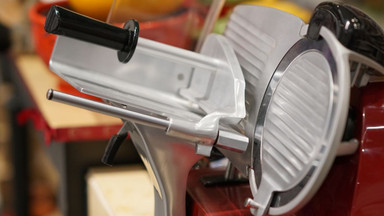May 13th 2020
Tips for Cleaning a Meat Slicer
Professional kitchens allocate as much time to cleaning, sanitizing, and maintaining their equipment as they do to preparing food. Some of the most useful machines are also the most challenging to clean. Bits of food can fall into small gaps between parts, and if they are left there, they can foster bacteria growth, creating the risk of food-borne illness. Cleaning these machines is critical to keeping customers and food businesses healthy. Here are tips for cleaning a meat slicer.
Prepare and Have a Spare
Meat slicers, also used to slice cheeses and even produce, should be cleaned and sanitized every four hours. Busy kitchens and delis use these machines almost constantly, so as a practical matter, they can’t be pulled out of service for cleaning unless there is another machine available to take over. Have a second (or third) clean machine ready to use when one machine is off-line for cleaning.
Unplug your electric meat cutter. Put on protective cut-resistant gloves and review the manufacturer’s instructions. These are directions, not suggestions. For staff and customer safety, it is important to review cleaning instructions every time.
Never use steel wool on your slicer. Never pressure wash or spray your slicer—this can damage the machine and cause rust by driving water into hidden gaps or seams. Make sure you have plenty of detergent and clean rinse water, as well as enough approved sanitizer, ready and available.
Set the Blade Thickness to Zero, Disassemble, and Clean Removable Parts
Set the blade thickness to zero. Use a soft cloth to remove large, obvious pieces of food residue. Then carefully disassemble the machine, removing the food chute or tray, the blade plate and guard, and the knife sharpener, if there is one. Use hot water and dish detergent to clean the parts, but never submerge the entire machine. Rinse thoroughly, sanitize with a safe, recommended product according to its instructions, and allow the parts to air dry.
Use exceptional care cleaning the blade itself. You may be able to clean both sides of the blade without removing it or choose to take it off to thoroughly (and very carefully!) clean and sanitize both sides. In addition to soap and water, a heavily used blade might benefit from a degreasing product.
Clean the Exterior and Cover at the End of the Day
Use a small, clean brush to scrub the exterior of the machine, including any knobs, screws, seams, and the handle. Don’t forget the center hole of the blade. Rinse it all with a clean towel and fresh water and apply sanitizer according to the instructions, allowing it to air dry.
When the machine is fully dry, reassemble it and use a food-grade lubricant as required by the manufacturer’s instructions. Cleaning and sanitizing the machine with the proper methods and food-safe products is critical to preventing food-borne illness and to keeping the machine in good working condition. Take your time, wear protection for both yourself and your customers, and follow the manufacturer’s instructions in every detail. Properly reassemble the machine before you reconnect it to a power source.
When all your slicers are clean at the end of the day, cover them to ensure they stay clean overnight. We hope these tips for cleaning a meat slicer help keep your business and your customers healthy.

